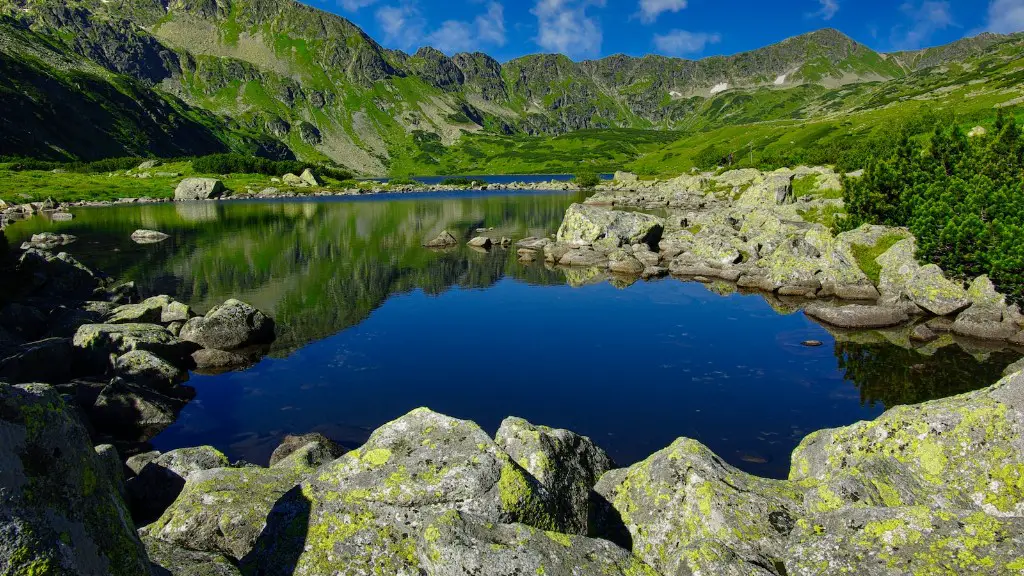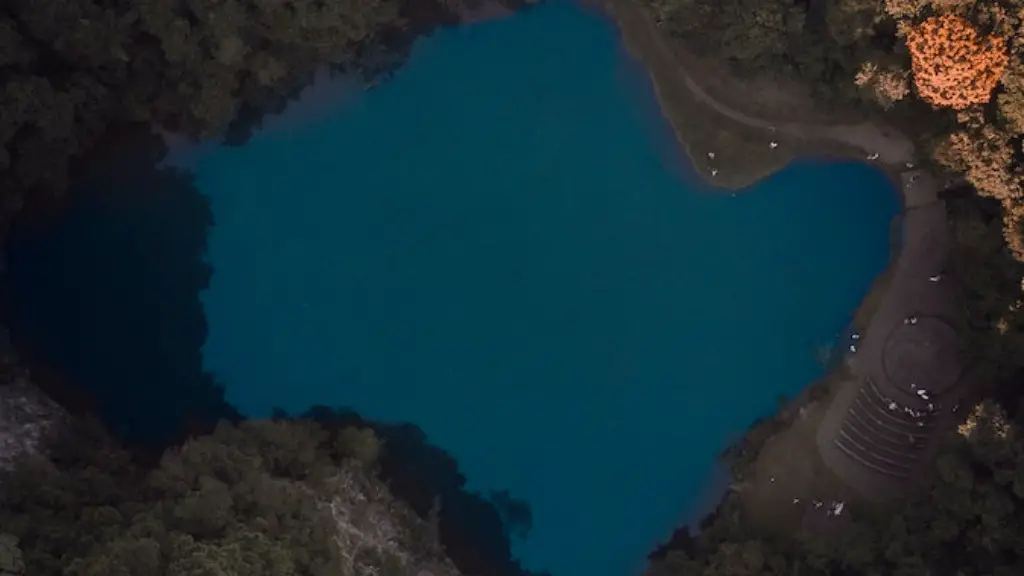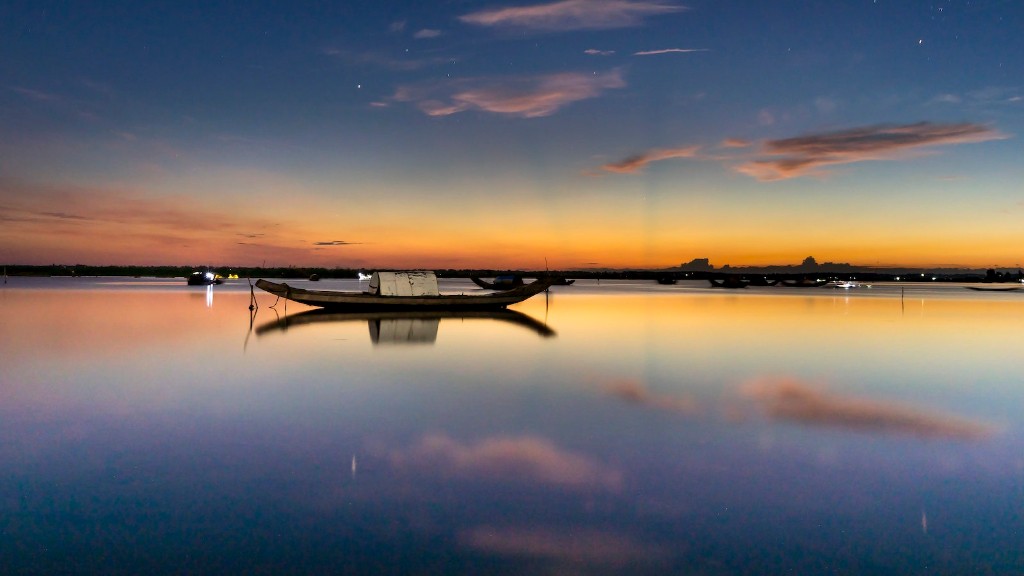Lake Michigan is renowned for its striking, deep blue colour. It is acclaimed as one of the most scenic and beautiful locations in the United States, yet few people understand why it is such a remarkable shade of blue. From the science behind the distinctive blue hues of the lake, to the conservation efforts that are being made to ensure the sustainability of Lake Michigan’s cobalt colour, there is a lot to discover in this peculiar and captivating phenomena.
The clue to the blue colour of Lake Michigan lies in its intricate chemistry. The lake is incredibly clear due to the fact that its waters contain very few suspended particles of salt, sediment, and other materials. More significantly, though, Lake Michigan contains a type of calcium carbonate (limestone) and other materials which together refract and absorb light in the green and blue end of the visible spectrum. As a result, the lake appears a deep blue to the human eye. This explains why the lake is especially appealing when there’s sunshine, because strong sunshine increases the level of blue hues in the lake’s colour.
The chemistry of Lake Michigan is highly sensitive and delicate, and it is this aspect of the lake which must be managed. For instance, the health of the lake is heavily dependent upon the input of nutrients, plant material, and other materials into the lake. The rate of human activities such as the fertilisation of agricultural land, the discharging of industrial and urban waste, and alterations to the lake’s habitat can all have an effect on the chemistry of Lake Michigan. Changes to the lake’s chemistry can upset the delicate balance of the naturally occurring particles that give the lake its distinctive colour.
Therefore, it is essential that all efforts are made to protect Lake Michigan’s natural chemistry and environment. The Lake Michigan Federation provides a number of resources and campaigns that are designed to ensure the sustainability of the lake’s chemistry and environment. The Federation has spearheaded a number of initiatives such as ‘Be Blue: Lake Michigan’s Future’, which is a programme that encourages organisations and individuals to participate in conservation efforts. Additionally, the Lake Michigan Federation also works to reduce the amount of aquatic nuisance species that have entered the lake, and to control the rate of nutrient input in the lake.
It is clear that the remarkable blue hue of Lake Michigan is owed to both its chemistry, and the efforts that are being made to ensure the sustainability of its environment. The deep blue shades of the lake should not be taken for granted, as it is a sight that is earned through the diligent efforts of conservationists, and the delicate balance of the lake’s chemistry.
Benefits to People
Lake Michigan provides numerous benefits to the people that live around it. The lake can act as a recreational and tourist destination, with swimming, fishing, and boating activities all popular members of the lake’s ecosystem. Additionally, some of the lake’s native fish species have become a source of income, with most fisheries dependant on the lake’s abundance of species such as Salmon and Trout.
The lake also has many historical significance, which further adds to its value. For example, Lake Michigan was the geographical centre of a settlement by the Potawatomi tribe, and the entire lake is watched over by the Manitou, the Native American spirit, who is believed to the the protector of the lake’s ecosystem. In addition, due to the lake’s natural beauty, it has been used as a feature in many paintings and photographs, as well as providing the backdrop to various films and TV shows.
Moreover, Lake Michigan has many health benefits. For instance, regular visits to the lake have been seen to reduce stress levels and improve sleep. Furthermore, the lake’s air and the body of water itself has properties that can act as natural remedies for depression, anxiety, and other psychological issues.
Environmental Factors Affecting The Lake
A variety of environmental factors play an important role in the ecology of Lake Michigan, as well as its famous blue hue. These environmental factors include both natural and human-induced occurrences. For example, the fluctuation in water temperature due to air temperature changes or alterations in precipitation or drainage patterns can result in changes in the lake’s chemistry and balance of organisms.
In addition, Lake Michigan is subject to the continual influx of unnatural chemicals, such as those found in fertilisers and polluting agents like lead. Nitrogen, phosphorus, and other substances in fertilisers can react with the water, leading to excessive algae growth and the depletion of oxygen levels in the lake. As the oxygen levels become depleted, fewer organisms are able to survive, thus leading to a reduced richness of the lake’s biodiversity.
Moreover, urban and industrial waste entered by the rivers that feed Lake Michigan can also have a profound effect on the lake’s ecology. Heavily polluted rivers with a significant input of chemicals can reduce the clarity of the lake’s waters, thus impacting the visibility and refraction of light that occur during the summer months when most of the lake’s blue hue emerges. This can deprive the lake of its iconic vivid blue colour.
Conservation Efforts Protecting The Lake
The blue colour of Lake Michigan is a fragile feature, which is why conservation efforts are so important. The Lake Michigan Federation is at the forefront of such efforts, using campaigns and resources to educate the public and promote conservation activities. The Federation has been successful in leading a number of initiatives, such as the Great Lakes Restoration Initiative, which cost $300 million in 2017. This project looks to restore the natural ecosystems of the Great Lakes, as well as remove toxic substances from the waters. Additionally, the Lake Michigan Federation has been actively involved in the management and identification of aquatic nuisance species, and have helped to reduce the levels of contaminants in the lake.
The Lake Michigan Federation’s policies and strategies should be applauded, as it provides a framework for the conservation of the lake, and serves as an example for others who wish to ensure the longevity of a natural wonder. Communities in the Lake Michigan region should be encouraged to get actively involved in conservation efforts, so that the lake’s glory and distinctive blue hues will continue to exist.
How People Can Help
For those that want to help protect Lake Michigan and its blue hue, there are plenty of opportunities available. People can start by taking part in local clean-up projects and initiatives organised by organisations such as the Lake Michigan Federation, which is actively looking for volunteers to assist on various conservation efforts.
In addition, people can take simple steps in their own homes to help protect the lake and its blue colour. This can include ensuring that any chemicals or detergents used in and around the home are disposed of responsibly, and informing themselves and their children about the importance of maintaining Lake Michigan’s unique environment.
Moreover, people should be aware of activities that can have a negative impact on the lake, such as littering and hazardous waste dumping. Avoiding activities that could potentially harm the lake, or notifying the authorities if the lake’s condition appears to be deteriorating are also effective ways that people can help protect Lake Michigan.
The Future of Lake Michigan
With the correct conservation protocols in place, Lake Michigan can continue to remain one of the most vibrant and visually striking locations in the United States. The lake’s blue colour is captivating to visitors and locals alike, which is why it is so important that the necessary measures are taken to protect the lake’s incredible chemistry.
By upholding the proper policies, organisations, and individuals can ensure that Lake Michigan retains its incredible blue hue. This is not only beneficial to visitors and locals of the Lake Michigan area, but to the entire nation, who should actively care for and be mindful of one of America’s most remarkable and precious resources.




